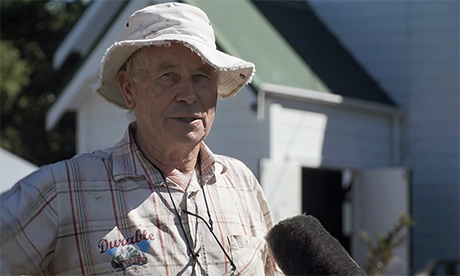One of Cyclone Gabrielle’s many casualties was a beautiful little Catholic chapel on the north side of Wairoa’s town bridge.
Like many places in Wairoa’s North Clyde area, St Therese’s was swamped.
Silt got into everything and did its worst.
The same happened at the marae next door – and to numerous homes and properties.
Everything may have been under water and silt or swept into the river, but people were wonderfully helpful, Br Denis O’Brien SM (pictured) says.
Memories of the flood’s suddenness and speed continue to amaze him.
His voice still sounds startled when he recalls how fast the water rose and the fence in front of the church was picked up and dumped across the road.
A big piece out the front wire gate is still somewhere in the paddock.
The water and silt got found its way into the chapel, even though the doors and windows were shut. It’s been swept out now, but the wall cavities are probably holding on to a fair amount of silt.
O’Brien says it’ll just have to stay there until the insurance company has decided what to do.
Individuals, families, the Council and businesses pulled together. Willing volunteers O’Brien can’t praise enough turned up.
A Mormon family who used to live across the road from the church came back to help clean up St Therese’s (locally known as the marae chapel) and the adjacent marae complex.
They came straight away, O’Brien says.
He says there wouldn’t usually be so many people around during the working week, but big local employer QRS (the Council-owned Quality Roading and Services) closed its operations and gave staff a chance to look after themselves and others.
Their help was desperately needed.
Over 100 North Clyde families had their homes flooded. Most weren’t insured. Many others in the valleys around them weren’t either.
Mud surrounds the Easter Candle
Many others came too – the QRS workers and their big machinery, individuals and families worked, cleared, and sorted.
Liam Greer, who is the Palmerston North Catholic diocese General Manager visited.
Just how much it will cost to right any ongoing concerns with the little Catholic chapel and what sort of insurance payout can be expected are questions for the future.
At the time of writing, Greer told CathNews he was waiting for the builder’s and insurer’s reports.
Until he’s seen these, he can’t comment, he says.
Washed in silt; organ has seen better days
Meantime, O’Brien says the parish is collecting money, as are various other local organisations. Just how it will be spent isn’t clear yet.
It will go where the need is judged greatest; a group, including local taiwhenua and council representatives, will decide how to apportion it, O’Brien says.
The same will apply to funds the diocese raises.
He explains that the diocese is just waiting to be told where and how to distribute it.
O’Brien suggested that the big question is where all the tradies are going to come from to do all the skilled work.
Until various essential skilled jobs are done, families are squashing together.
Source
